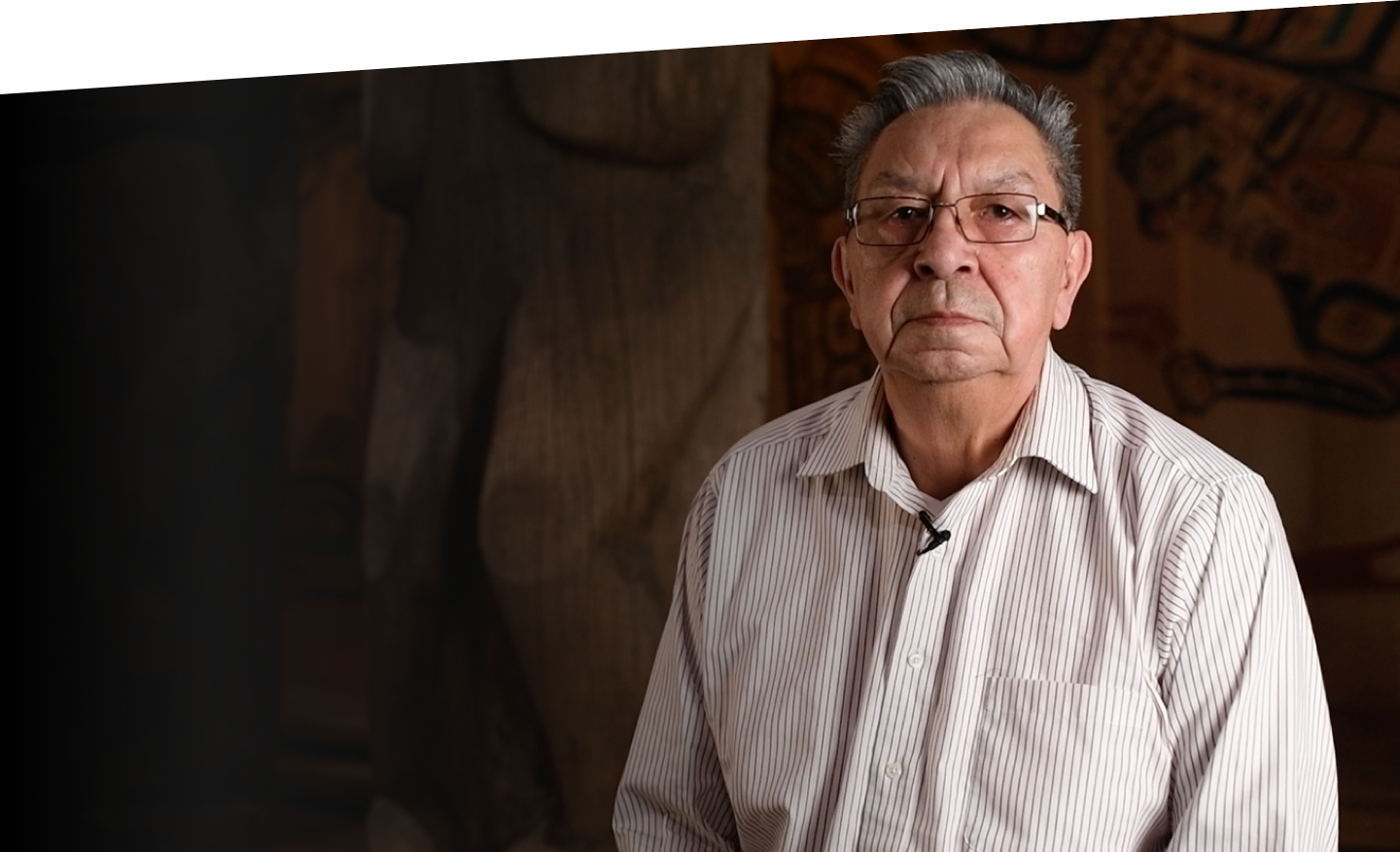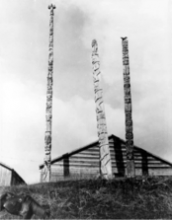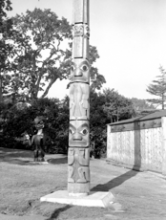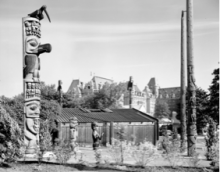JOURNEY
Origin
The Split Person Pole was carved in the village of Gitanyow, located in Northwestern British Columbia along the Kitwanga River just south of Kitwancool Lake. The village, formerly known as Kitwancool, changed its name in the early 1980s. Gitanyow means People of Many Numbers.
Although usually grouped with the Gitxsan-speaking peoples, the Gitanyow consider themselves an independent and autonomous group. Their legal system is based on clearly articulated adawaak (oral traditions) and ayookxw (laws), and the figures on their poles articulate these legal principles.
Hereditary Chiefs govern the Gitanyow in the traditional way as the heads of eight wilps (a wilp is a house group). Each wilp has a specific territory that is expressed on its git’mgan (totem pole). Not only does the pole depict the family’s history, it proclaims their inherited rights to specific lands and resources. In Gitanyow law, the Hereditary Chiefs and the huwilp (house groups) have the responsibility of protecting and passing on the lax’ip (territory) to the next generations.
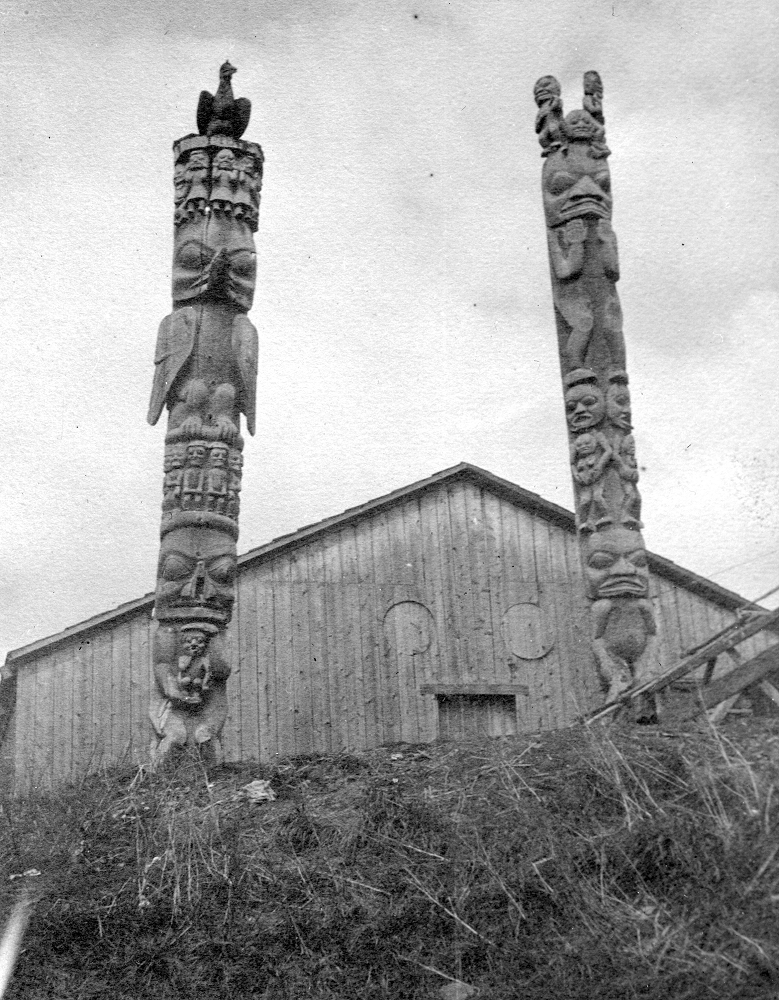
View of Chief Weerhoe’s house at Gitanyow, 1910, with the Gaa-quk-dik-giat (right), known as the Split Person pole, and the Skim-sim and Will-a-daugh pole in front. George Emmons photograph. A-06907.
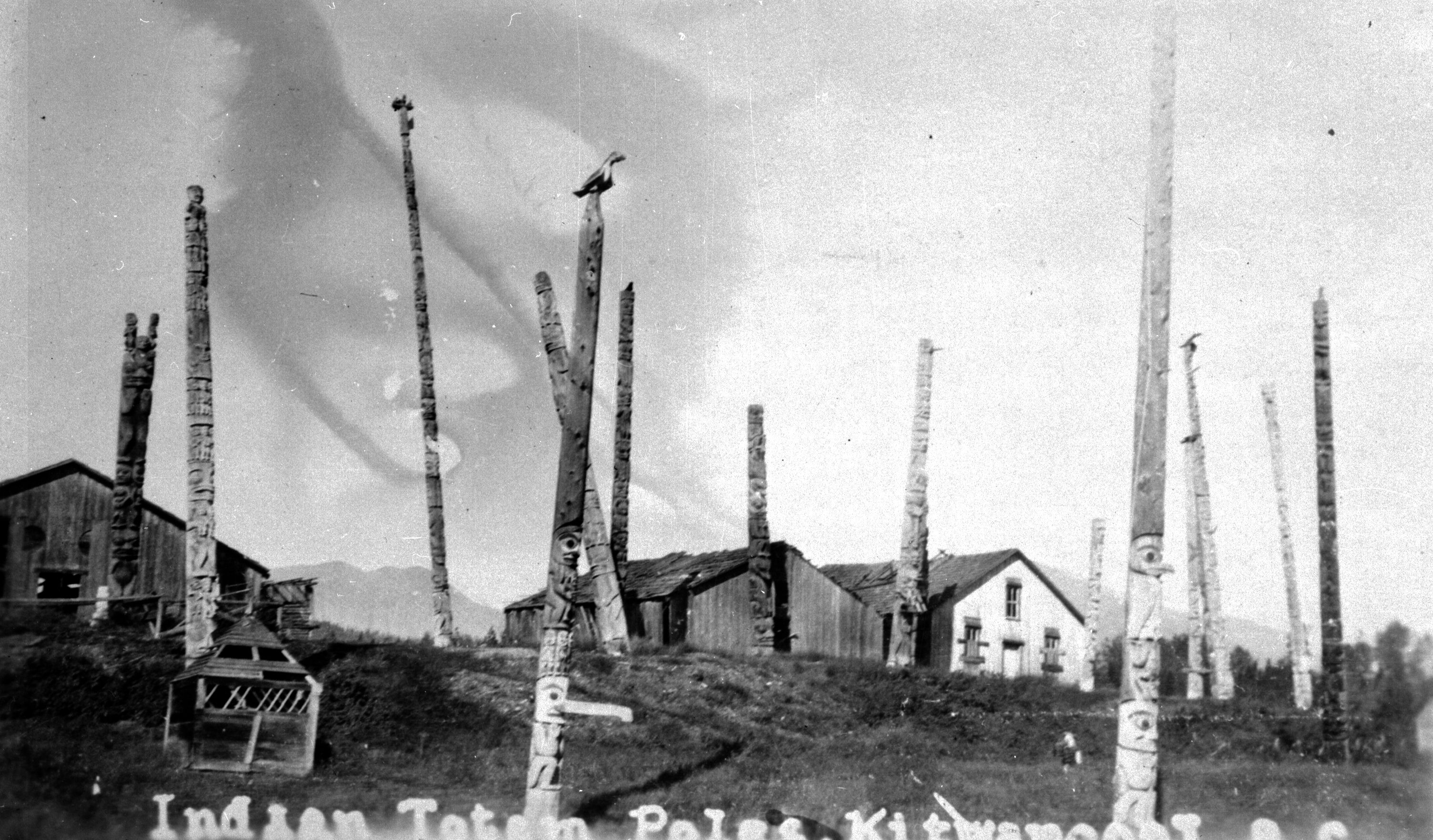
The Gitanyow carefully guarded their traditions, but as the village was accessible by road the impressive poles were much photographed, and the images widely distributed. The Split Person pole is on the extreme left in this image taken about 1910. B-01303.
The Split Person, or Twins, pole belongs to the Weerhoe family of the Lax Gibuu (Wolf clan), one of two clans of the Gitanyow. The other clan is Lax Ganeda (Frog/Raven). Each of the large figures on the pole symbolizes one of the family’s ayuuks (crests), depicted as a human figure with two heads and a single body. The Split Person crest is said to have originated on the Nass River, and so the pole’s creator may have been a Nass River carver.
This pole has also been called the pole of Chief Gwaas Hlaam. Chief Biiyosxw, Harry Daniels, from the wilp Gwaas Hlaam in Gitanyow explains that the figures on the pole represent a woman—an ancestor of the wilp—who was taken away by a supernatural mountain eagle and whose children were part bird, part human.
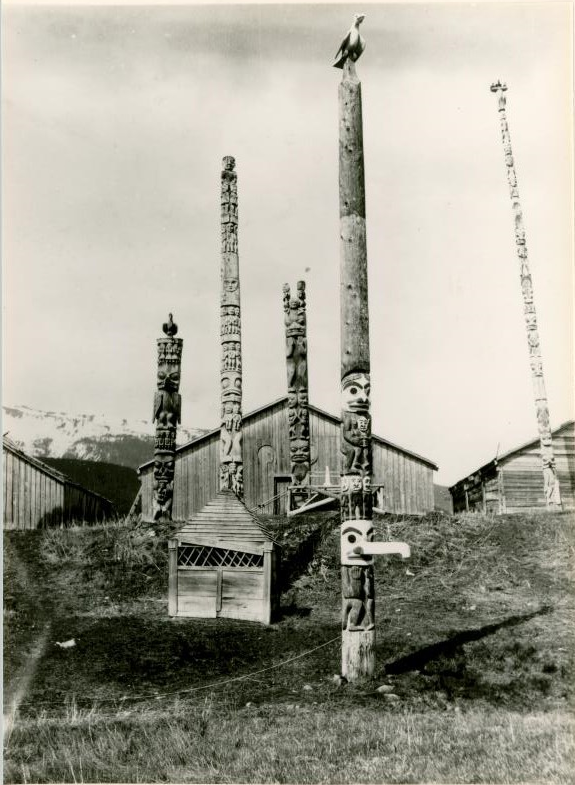
A view of the centre of Gitanyow village looking north, with the Split Person pole (third from left) in front of the house of the Weerhoe family of the Lax Gibuu (Wolf clan), 1910. George Emmons photograph. PN 4035.
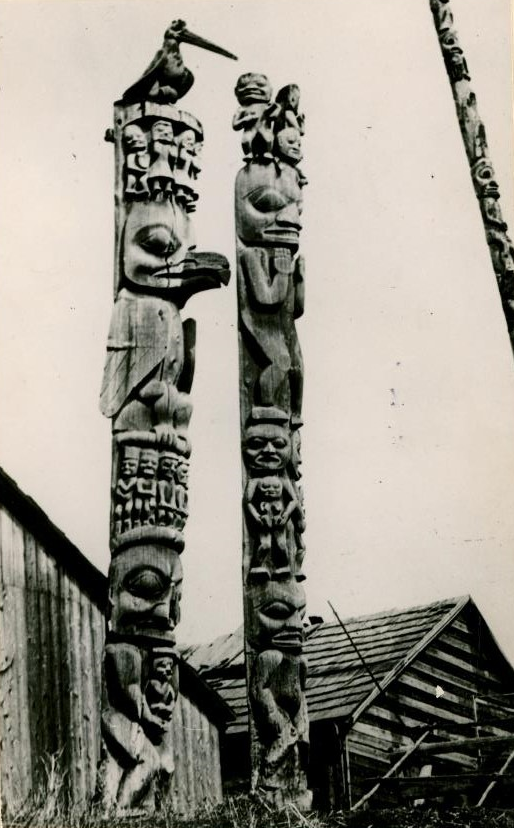
Poles of the Lax Gibuu (Wolf clan) at Gitanyow, 1910. The pole of Gaa-quk-dik-giat, known as the Split Person pole, is on the right. The other pole is the Skim-sim and Will-a-daugh pole. George Emmons photograph. PN 3817.
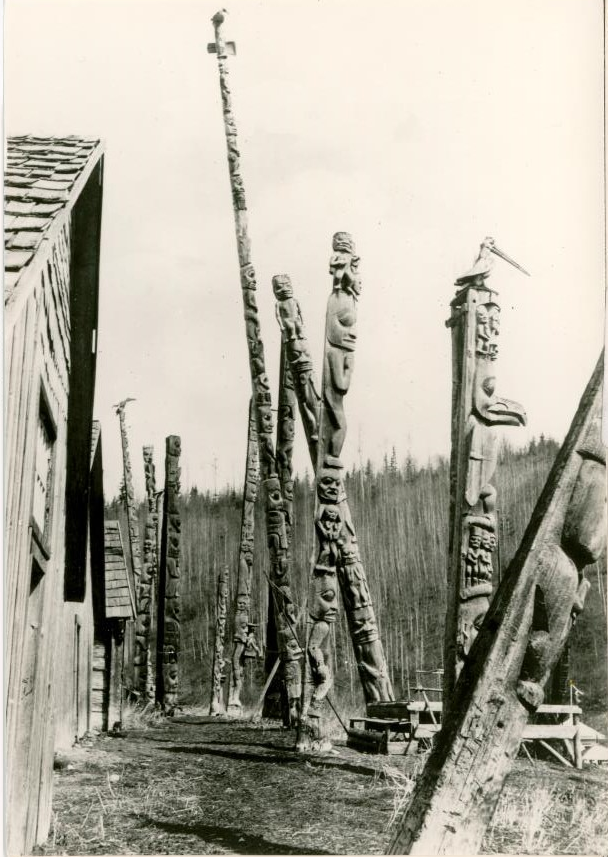
A view of the Gitanyow poles from the side with the Split Person pole in the centre, 1910. George Emmons photograph. PN 1228.
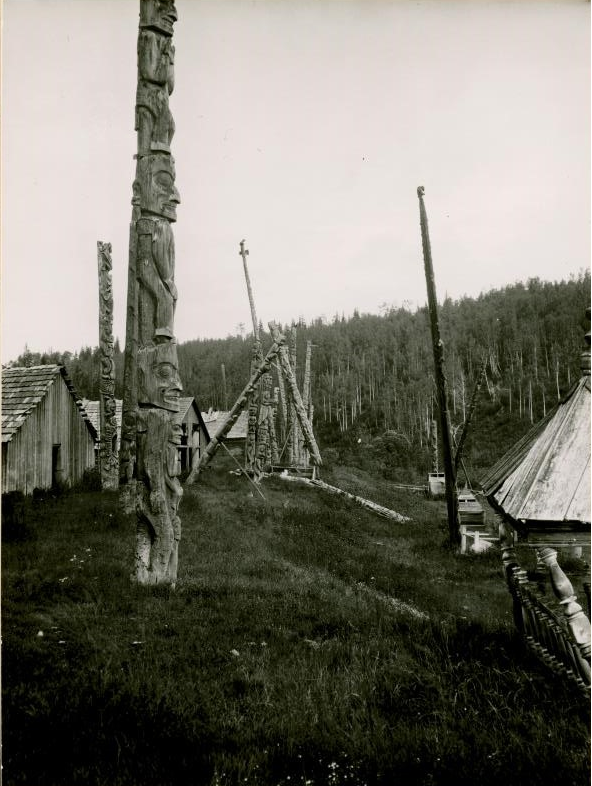
In 1910, some of the poles were leaning or had fallen. George Emmons photograph. PN 3977.
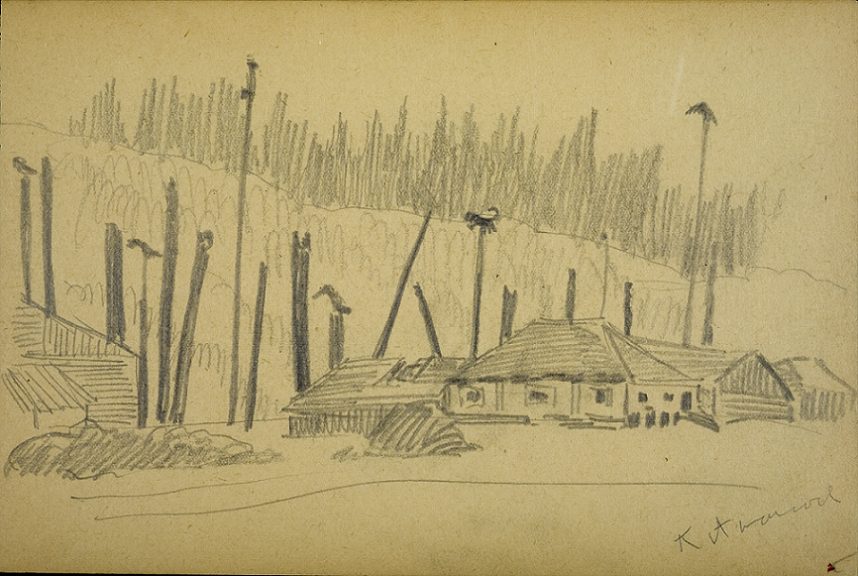
A pencil sketch of Gitanyow, then known as Kitwancool, by Emily Carr, probably made during her 1928 trip to the Nass and Skeena Rivers. PDP05799.
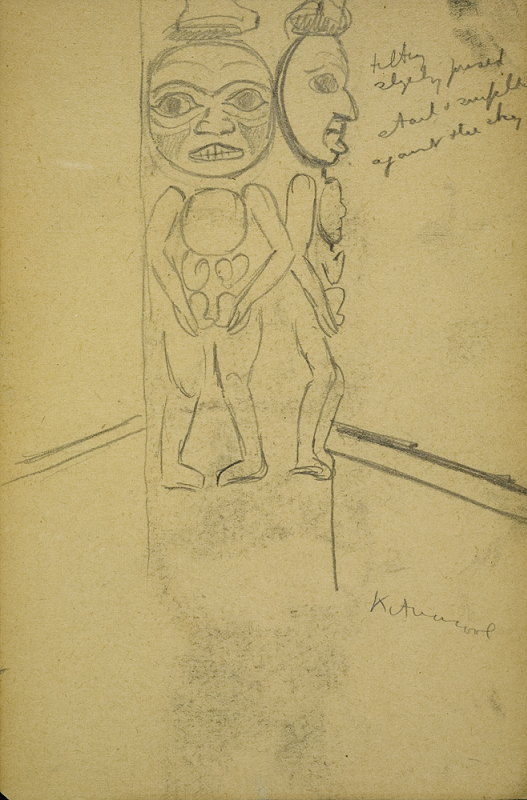
One of the sketches Emily Carr made at Gitanyow in 1928 shows figures at the top of the Split Person pole. PDP05805.
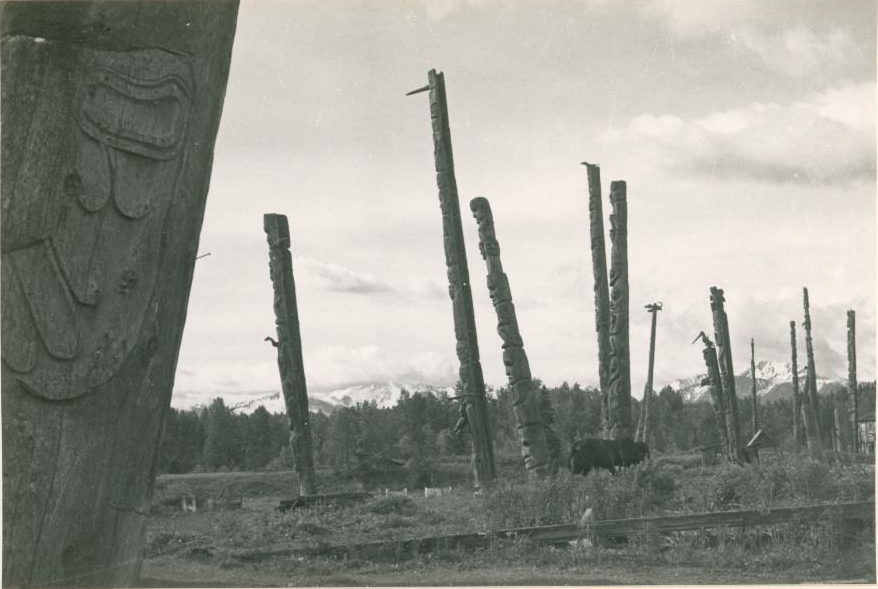
The poles at Gitanyow in 1949. Wilson Duff photograph. PN3997.
JOURNEY
Removal
Wilson Duff, then curator of anthropology at the provincial museum, was instrumental in bringing about the first formal collaboration between a museum and a Northwest Coast First Nation. In 1958 he travelled to Gitanyow (then called Kitwancool) with Michael Kew, a University of British Columbia anthropologist, to negotiate the removal of a small number of poles for preservation in Victoria and Vancouver.
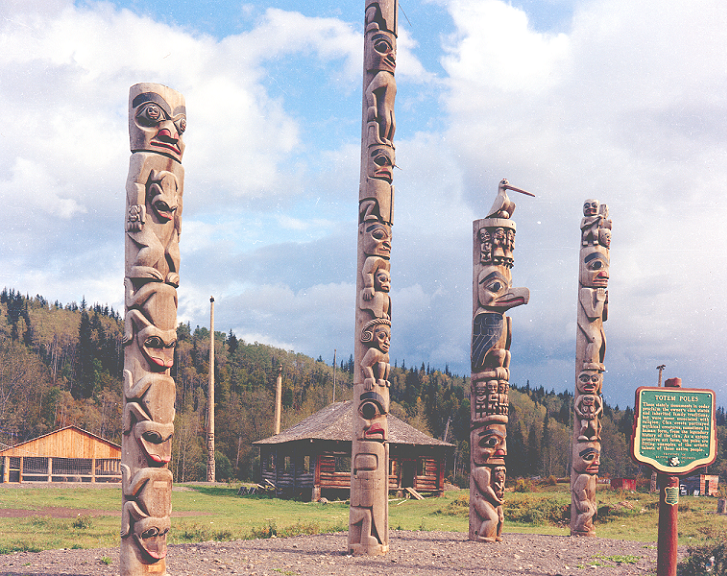
View of the replica poles at Gitanyow, 1980. The Split Person pole is on the right. Next to it is the Skim-sim and Will-a-daugh pole, the original of which went to the UBC Museum of Anthropology. On the left is the All Frogs pole, the original of which stands in the Royal BC Museum’s main lobby. Another replica of the Skim-sim and Will-a-daugh pole is in the Royal BC Museum’s Thunderbird Park. I-15825.
They signed a formal agreement with the Gitanyow hereditary chiefs who owned the poles, and recorded the histories, territories, and laws that the poles signify. These are published in Histories, Territories and Laws of the Kitwancool (Royal BC Museum 1959, reprinted 1989). In the book’s preface, Duff described how the agreement was worked out:
Discussions with representatives of the Kitwancool had been carried on in previous years, but up to that time no totem-pole had ever been removed from the village. The Kitwancool chiefs did not consider it proper, under any circumstances, to sell their totem-poles outright. Accordingly, we made a new kind of offer: that for each old pole which we removed for preservation, a new and exact copy, carved in Victoria, would be returned and erected in the village.
A meeting of the chiefs and people of Kitwancool accepted this proposal, but added one further condition: that their histories, territories and laws were to be written down, published and made available to the University for teaching purposes. Since that described precisely one of the functions the Museum is trying to perform, we were happy to agree.
The agreement recognizes First Nations ownership and authority, thus signalling a new way of thinking about museum collections. The resulting book, Histories, Territories and Laws of the Kitwancool, details the history of the poles, including the Split Person pole, as recounted by Chief Wee-kha, Ernest Smith.
The authors of this book are the Kitwancool themselves, for it contains their own statement of what they consider to be their histories, territories and laws.” –
Wilson Duff, from the preface.
JOURNEY
Today
The original pole was cut in two when it was transported from its original site. The halves now stand side by side in the First Peoples Gallery. The replica of Split Person pole stands at Gitanyow.
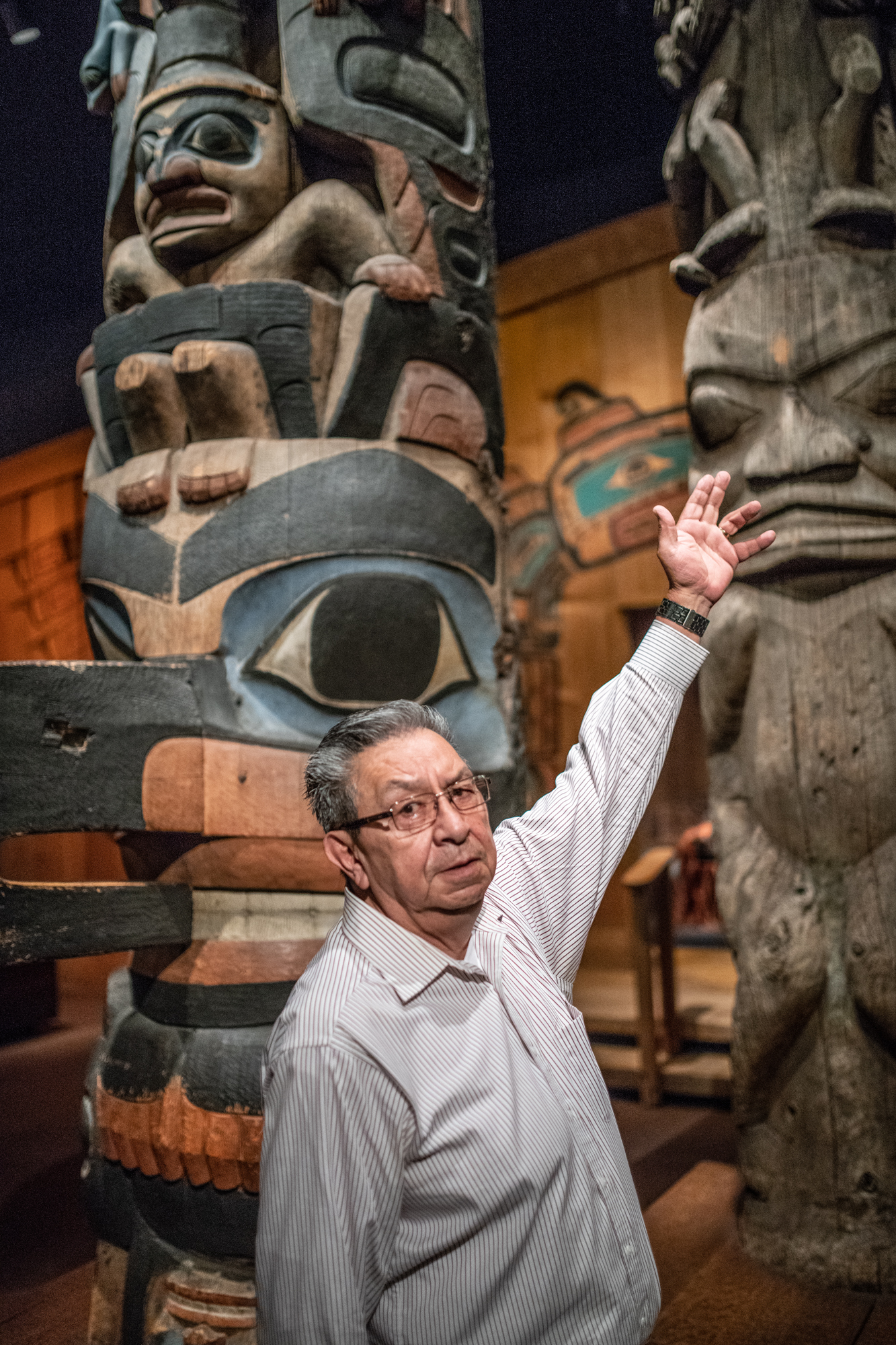
Chief Biiyosxw, Harry Daniels, from the wilp Gwaas Hlaam in Gitanyow explains that the figures on the pole represent a woman—an ancestor of the wilp—who was taken away by a supernatural mountain eagle and whose children were part bird, part human. Gitanyow poles embody the histories of the people and document Gitanyow rights to their territories between the Skeena and the Nass River in northwest British Columbia.
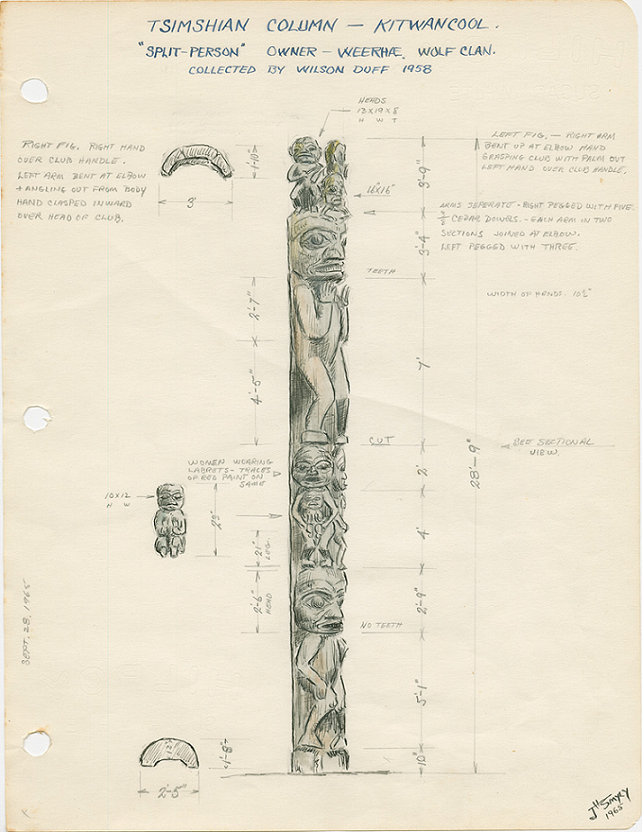
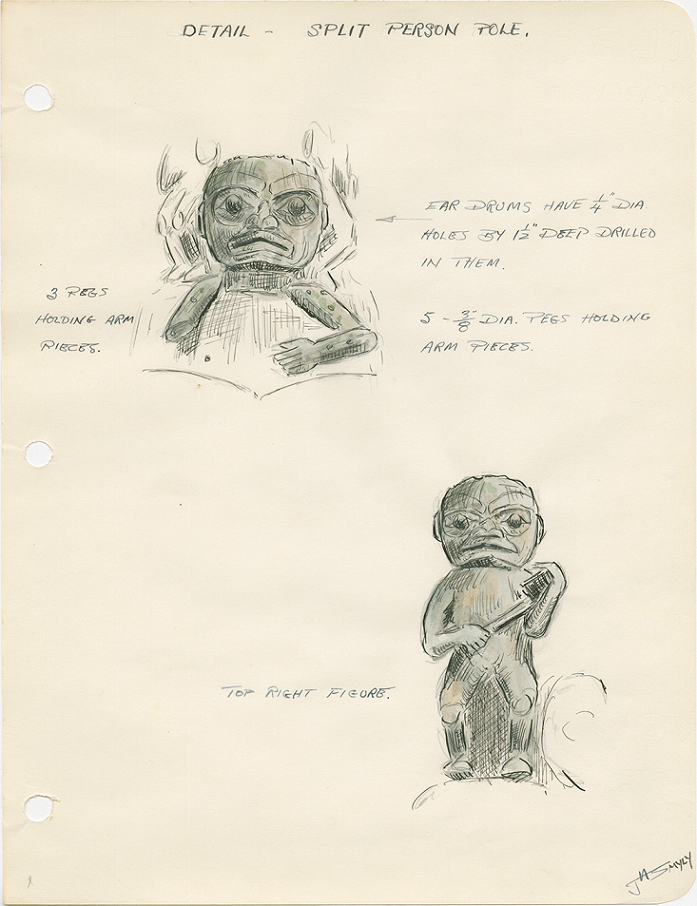
John Smyly, a museum technician, made detailed drawings and documented the work done by the museum to restore and stabilize the posts.
CONNECTIONS
Related Carvings
Kolin Sutherland-Wilson
Kolin Sutherland-Wilson
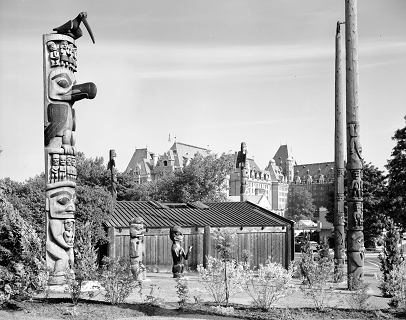
Kolin is Gitxsan from the Village of Anspayaxw. He is currently an undergraduate student at UVic in the departments of Indigenous Studies and Environmental Studies. He received assistance and guidance with the Gitxsan language portion of the Virtual Totem Gallery from Art Wilson and Dr. Jane Smith.
Explore a curated selection of Royal BC Museum objects and contemporary photographs that inspire this community member to continue working in the tradition.
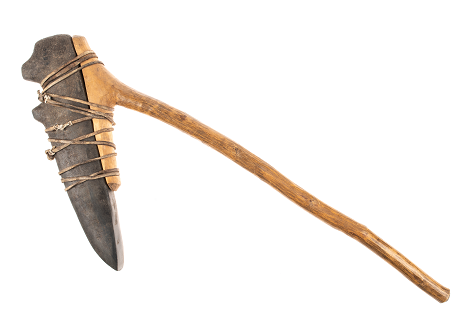
The stone adze was used since ancient times
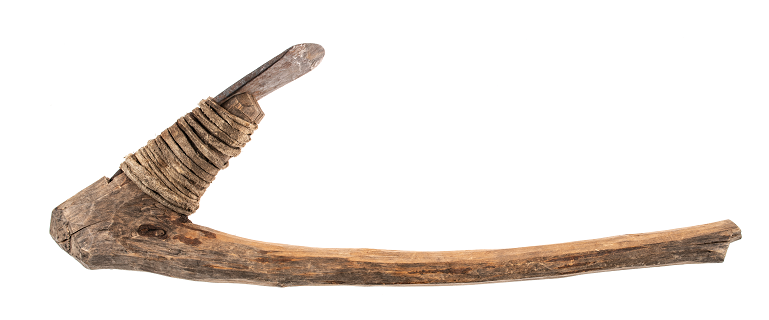
Closer to our era, we started using steel adzes
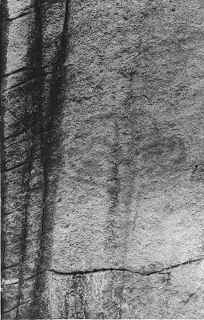
The cedar [used in totem poles] is the most used tree by the Gitxsan.
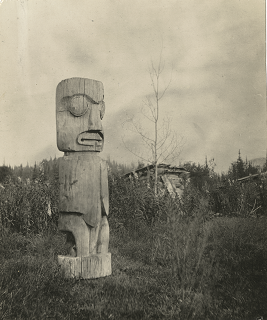
A hereditary chiefs marker in Kuldo.
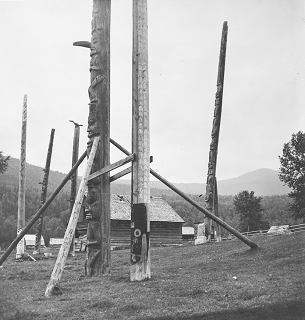
These poles are braced up, after the flood in 1936
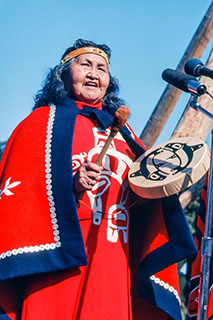
The adaawk on a totem pole is consistent with a chiefs blanket and the songs that are born out of that history
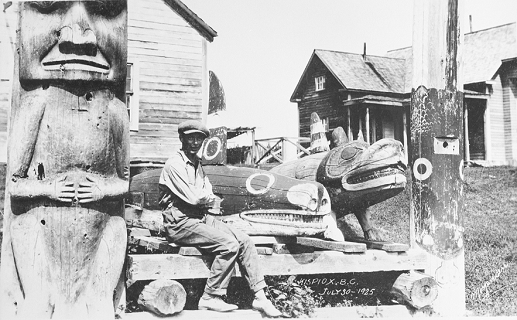
These [crests] represent a hereditary chief
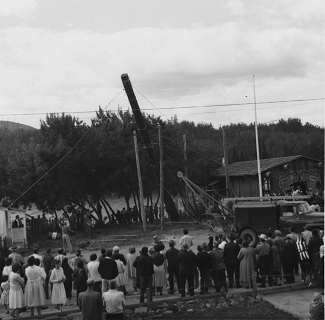
A typical pole raising by hereditary chiefs
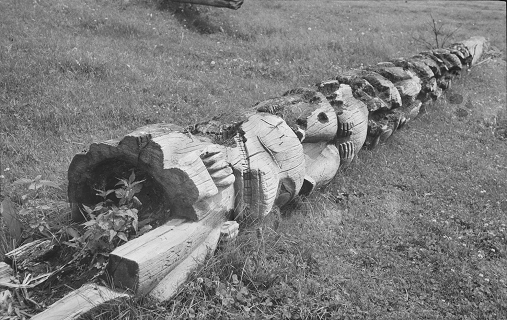
The remnants of an old pole
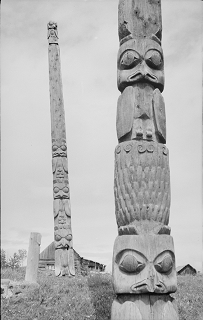
[A totem] ensures that there are no changes to the history. It is a Gitxsan law that chief does not lie
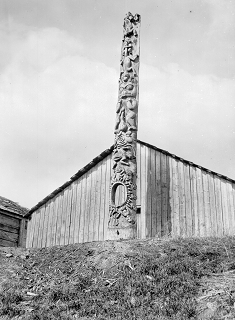
The totem represents the most significant history of the family
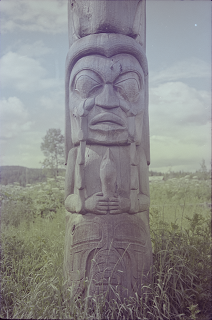
A part of Tsi’basaa’s totem pole
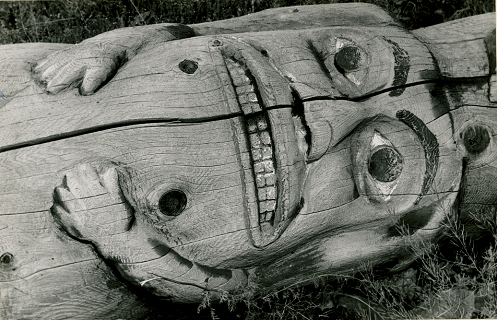
The carver creates the ancient spirit
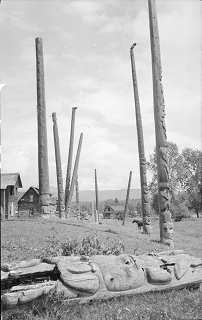
[In replicating a totem pole] they carve it the exact same way, nothing is changed, it still follows the history
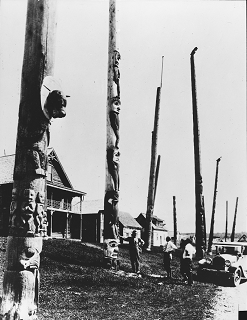
What is described here was born in times immemorial


